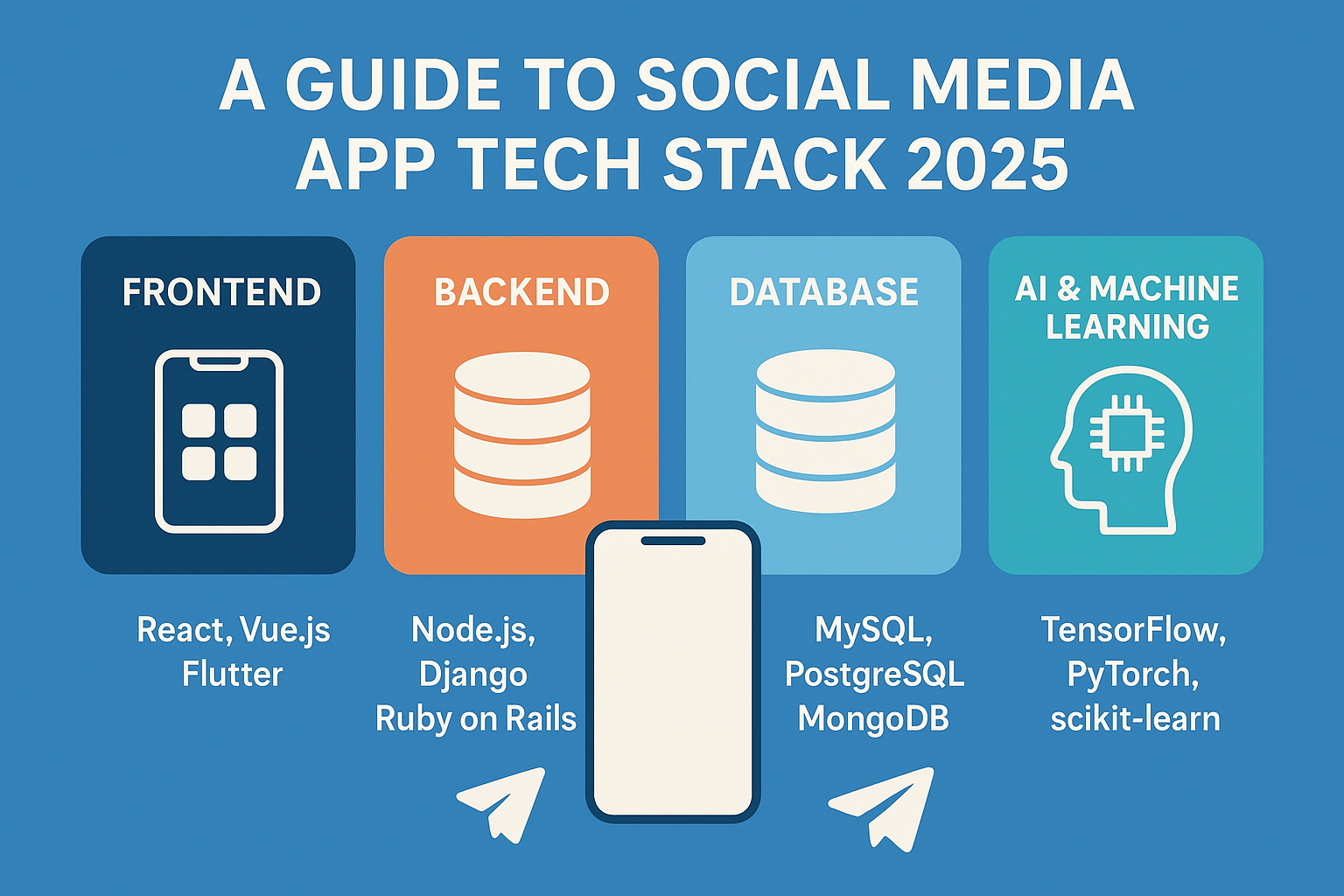In 2025, social media platforms are no longer just about connecting people — they’re about creating personalized digital experiences powered by AI, machine learning, and real-time data.
Behind every successful social media app — whether it’s Instagram, Threads, or Clubhouse — lies a powerful and carefully chosen tech stack that ensures scalability, speed, and innovation.
If you’re planning to build your own social media app, understanding the tech stack is your first step toward long-term success.
This guide breaks down the complete social media app tech stack for 2025, explores the latest trends, and explains how Boxinall can help you craft a high-performing solution.
Key Takeaways
✅ Selecting the right tech stack lays the foundation for scalability, performance, and long-term success.
✅ A balanced combination of frontend, backend, and database technologies ensures a seamless and secure user experience.
✅ Modern stacks combine React Native or Flutter (frontend), Node.js or Django (backend), and MongoDB or PostgreSQL (database).
✅ Integrating AI, ML, and NLP enhances personalization, engagement, and real-time content recommendations.
✅ Continuous evaluation of emerging tools keeps your app aligned with evolving user expectations and trends.
✅ Partnering with Boxinall gives you access to expert developers who design scalable, modern, and efficient social media apps.
1. Why Your Tech Stack Matters in 2025
Your tech stack isn’t just a list of tools — it’s the DNA of your social media app.
In 2025, user expectations are higher than ever:
- Instant content delivery
- AI-powered recommendations
- Cross-platform performance
- Real-time chat and notifications
A poor tech stack can result in lag, data loss, or crashes under load, which directly affects user retention.
Choosing the right stack early helps you build a product that’s scalable, secure, and cost-efficient.
2. Core Components of a Social Media App Tech Stack
Let’s break down the major building blocks:
Frontend (User Interface Layer)
This is what users interact with — the screens, animations, and layouts.
Top Frontend Choices (2025):
- React Native: Write once, deploy on Android & iOS. Backed by Meta, great for cross-platform social apps.
- Flutter: Google’s fast, UI-rich framework with native performance and beautiful designs.
- Next.js (for Web): Enables SEO-friendly web apps with server-side rendering.
Why Boxinall uses them:
These frameworks allow Boxinall’s developers to build fast, scalable, and visually stunning UIs that work flawlessly across devices.
Backend (Server-Side Engine)
The backend handles business logic, APIs, authentication, and real-time communication.
Top Backend Frameworks (2025):
- Node.js: Lightweight and event-driven; ideal for real-time apps like chats or live feeds.
- Django (Python): Secure, fast, and perfect for data-heavy applications.
- Ruby on Rails: Great for rapid MVP development.
Scalability Stack Add-ons:
- Socket.io or Firebase for real-time messaging.
- Redis for caching and session management.
- GraphQL for flexible data queries.
Why Boxinall uses them:
Boxinall’s engineers design modular and scalable APIs to support millions of concurrent users without performance issues.
Database Layer
Social media apps handle massive volumes of data — user profiles, messages, comments, images, and more.
Top Database Options:
- MongoDB: Flexible NoSQL database; perfect for dynamic and unstructured data.
- PostgreSQL: Reliable relational database with strong ACID compliance.
- Firebase Realtime Database: Excellent for instant data sync across devices.
Boxinall’s Approach:
Combining MongoDB for scalability and PostgreSQL for transactions, Boxinall ensures your app never slows down — even under high traffic.
Cloud & DevOps
To scale your app globally, cloud infrastructure and automation are key.
Preferred Cloud Solutions:
- AWS / Google Cloud / Azure for hosting.
- Docker & Kubernetes for containerized deployment.
- CI/CD pipelines (Jenkins, GitHub Actions) for faster updates.
Boxinall advantage:
They integrate automated deployment pipelines and load balancing for smooth scaling and zero downtime.
3. Integrating AI, ML & NLP in Social Media Apps
AI is redefining how social media works in 2025. From TikTok’s For You feed to LinkedIn’s post suggestions — AI and ML make experiences more relevant.
AI/ML Use Cases:
- Personalized content feed
- Fake account detection
- Hashtag and topic analysis
- Sentiment-based recommendations
- AI-driven moderation
Top Tools:
- TensorFlow, PyTorch for ML modeling
- OpenAI APIs for NLP and text generation
- AWS SageMaker for model deployment
Boxinall’s Edge:
Boxinall integrates AI-driven analytics and recommendation systems that boost engagement and retention.
4. Example Tech Stack for an Instagram-like App (2025)
Here’s what a modern architecture looks like:
| Layer | Technology | Purpose |
|---|---|---|
| Frontend | Flutter / React Native | Cross-platform mobile development |
| Backend | Node.js + Express | API handling and real-time feed |
| Database | MongoDB + Redis | Data storage and caching |
| Cloud | AWS + Docker + Kubernetes | Hosting, scaling, deployment |
| AI Tools | TensorFlow, OpenAI | Content recommendation, NLP |
| Analytics | Google Firebase, Mixpanel | User engagement tracking |
5. Cost Breakdown: Building a Social Media App by Tech Stack
| Type | Description | Estimated Cost (USD) |
|---|---|---|
| MVP (Basic Features) | Feed, profiles, chat | $25,000 – $40,000 |
| Mid-Level App | AI suggestions, stories, reels | $50,000 – $80,000 |
| Enterprise-Grade | Advanced ML, moderation, analytics | $100,000+ |
(These are indicative; Boxinall customizes based on scope and scale.)
6. Performance Optimization Techniques
A social media app must be fast and reliable.
Boxinall focuses on:
- CDN Integration (Cloudflare, AWS CloudFront)
- Lazy loading and image compression
- Microservices architecture for modular scalability
- Load balancing and caching for real-time updates
7. Future Tech Stack Trends (2026 & Beyond)
- Decentralized Social Networks (Web3)
- Blockchain-based identity & data ownership
- AR/VR filters powered by Unity & ARKit
- Serverless architectures (AWS Lambda, Firebase Functions)
- Edge computing for ultra-fast delivery
The future will blend AI, blockchain, and immersive media, creating the next evolution of social connectivity.
8. Why Choose Boxinall for Your Social Media App Development
With years of experience in mobile and web app development, Boxinall delivers end-to-end solutions — from concept to deployment — using the most modern and scalable tech stacks.
What Makes Boxinall Stand Out
- Expertise in AI-powered app architecture
- Skilled in cross-platform frameworks (React Native, Flutter)
- Proven record of launching high-performance social apps
- Focus on user experience, security, and speed
When you partner with Boxinall, you get a dedicated team that understands your business goals and translates them into a powerful, scalable, and future-ready social platform.
Conclusion
Building a social media app in 2025 isn’t just about design and features — it’s about choosing the right tech foundation.
A balanced stack ensures performance, scalability, and innovation, keeping your platform ahead of the curve.
Whether you’re building a niche community app or the next viral platform, Boxinall helps you create technology that lasts, scales, and performs — now and in the future.



